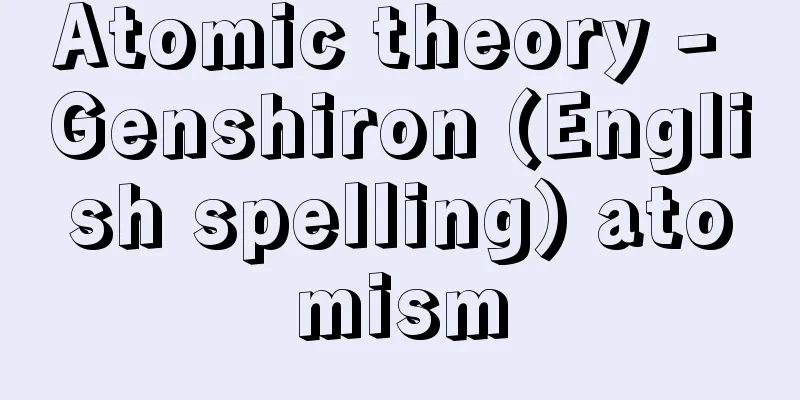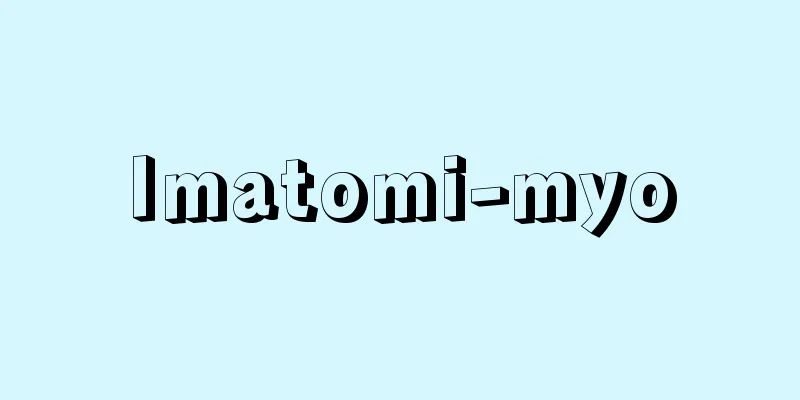Atomic theory - Genshiron (English spelling) atomism

|
A fundamental view of nature that nature is made up of tiny particles (atoms) that cannot be divided any further and a vacuum. It takes the position of discontinuity versus continuity, mechanism versus teleology, and materialism versus idealism. It was first proposed in ancient Greece in the 5th century BC by Leucippus and his student Democritus. After Parmenides logically criticized the monism of Thales and others, who preached that the world is homogeneous and unchanging, this pluralism was devised to defend the creation and destruction of reality. Like Parmenides' "things that are," atoms have a uniform and unchanging substance, but only their size and shape differ. Countless atoms move through an infinite void, and mechanically combine or separate like hooks and needles when they collide, causing various changes in the world. The differences between objects are only due to differences in the atoms and their arrangement. Although these ancient atomic theories were partially modified (e.g. I. Newton's forces instead of mechanical bonds, J. Dalton's spheres instead of various shapes, etc.), they maintained the basic concept of indivisible and unchanging atoms with uniform substance. This theory was opposed by Aristotle, an idealist elementalist, and in ancient times it was only inherited by Epicurus and his school as the basis of moral philosophy. Atomism remained in decline even in medieval Islam and Europe, where Aristotelian theories were popular, but the concept of particles was latent in Aristotelian theories, and scholastic scholars discussed various aspects of the smallest particles (minima) of nature. Minima have their own properties, and changes in objects are due to internal changes in the constituent minima, which makes them different from atoms. However, over time, they became intertwined with atomic theory. During the Renaissance, humanists translated and introduced ancient atomic theories, and as a result, particle theory and atomic theory became popular. The introduction of Epicurean theory by the French priest Gassendi (1649-), along with Torricelli's discovery of the vacuum (1643), played a major role in popularizing atomic theory, and had a strong influence on R. Boyle and others. Boyle's theory of hierarchical particle structure, which assumes a relatively stable particle assembly between atoms and macroscopic objects, was a precursor to the later atomic and molecular theories. On the other hand, the element theory, which was opposed to atomic theory in ancient times, began to approach atomic theory as chemists began to think that there were things that were preserved without undergoing change during chemical reactions. The Dutchman Zennert's assumption of four types of atoms or particles corresponding to the four elements was a manifestation of this. However, the complete combination of the theory of elements and atomic theory was not achieved until the birth of the modern theory of elements, which swept away the theory of the four elements. In 1803, the Englishman Dalton associated Lavoisier's elements with atoms and compounds with molecules (composite atoms), and calculated their relative weights. This was the first time that different types of atoms were defined almost empirically by weight. As a result, the atomic theory, which had previously had a predominantly philosophical tendency, became worthy of the name of science, and together with Lavoisier's theory of the elements, it revolutionized chemistry and produced fruitful results. The Swede Berzelius continued to make efforts for many years to determine accurate atomic weights. However, due to the lack of a consistent basis for determining the number of atoms in a molecule, some chemists were skeptical of atomic theory, despite supporting evidence such as the law of multiple proportions, and some began to use equivalent weights instead of atomic weights. Avogadro's hypothesis (1811), which reconciled Gay-Lussac's law of gas reactions with atomic theory by assuming polyatomic molecules in a single molecule, was supposed to solve this problem, but was considered to lack empirical support. In organic chemistry, which was new in this century, the uncertainty of atomic weights caused confusion as the molecular formula of a single compound was determined in various ways. In order to solve this problem, a separate print of Cannizzaro's paper distributed after the closing of the International Congress of Chemists held in Karlsruhe, Germany (1860) provided empirical support for Avogadro's hypothesis, and finally settled the issue of atomic weight. As a result, the concept of atomic valence, which had already begun to emerge, became clear, leading to the development of organic chemical structure theory and the discovery of the periodic law by J. L. Mayer and Mendeleev (1869). The latter revealed that "the chemical and physical properties of the elements depend in a periodic manner on their atomic weights" (Mendeleev), and completed the unification of elements and atoms that Dalton had initiated in both name and reality, although its essence was not elucidated until the 20th century. Atomic theory was also successful in other fields. In particular, the kinetic theory of gas molecules established a branch of chemistry and marked the beginning of statistical thermodynamics (Boltzmann). The elucidation of Brownian motion based on atomic theory, and especially the experimental verification of Einstein's diffusion equation, eliminated skepticism about atomic theory. The atomic science of the 20th century, which began with the discovery of electrons and radioactivity at the end of the 19th century, has revealed that atoms, which were thought to be indivisible and immutable, have internal structures and can be transformed into other things, transforming atomic theory into a historical concept, while proving the existence of atoms as a hierarchy in nature. Alchemy, which was popular in medieval Europe, i.e., an attempt to create expensive gold through chemical reactions, has become impossible in principle. Alchemy, which transforms elements, can now be performed using nuclear reactions, even if it is not profitable. It is also being considered for application to the treatment of radioactive materials from spent nuclear power plants. The concept of particles that cannot be divided any further, or the smallest particles in nature, was the driving force behind the discovery of elementary particles such as electrons and nuclei that make up atoms, and further protons and neutrons that make up atomic nuclei, and Yukawa mesons. Today, the existence of quarks has been established as the smallest units that make up elementary particles. [Yoshihito Hijioka and Yasuhisa Abe] Indian Atomic TheoryIn India, various theories of elements have been developed since ancient times, but around the time of Christ, logical reflection was added and atomic theory was formed. Atomism was especially advocated by Buddhist Abhidharma scholars, Jains, and the Nyaya and Vaisheshika schools. According to the Nyaya and Vaisheshika schools, all matter is composed of the elements of earth, water, fire, and air, but each element cannot be divided infinitely. If it were possible to divide it infinitely, a huge mountain and a tiny poppy seed would both be made up of infinite parts, and there would be no basis for comparing large and small. Therefore, a basic unit that cannot be divided any further is required. This basic unit is the atom. Therefore, atoms have no parts, that is, they are not composed of other things, and are eternally immortal. Two atoms make up a diatomic body, and three diatomic bodies make up a triatomic body, and so on, and all things in the world are composed of these things, but the smallest thing we can see with our naked eyes is said to be a triatomic body. [Keiichi Miyamoto] "The History of the Atom, by B. Schoonland, translated by Hiroshige Toru et al. (1971, Misuzu Shobo)" ▽ "Who Has Seen the Atom?, by Ezawa Hiroshi (1976, Iwanami Shoten)" ▽ "The Atomic Theory of Matter: Creative Science Lessons with Students, by Furukawa Chiyoo (1989, Corona Publishing)" ▽ "The Sources of Atomic and Molecular Theory, vols. 1-3 (1989-1993, Society Publishing Center), edited by the Society of Chemical History (1989-1993, Society Publishing Center)" ▽ "Ancient Greek Atom Theory, by Nishikawa Ryo (1995, Keisui-sha)" ▽ "The History of Atomic Theory, Vol. 1: Birth, Victory, and Expulsion, and The History of Atomic Theory, Vol. 2: Revival and Establishment, by Itakura Seinobu (2004, Kaesetsu-sha)" [References] | | | | | | | | | | | | | | | | |Source: Shogakukan Encyclopedia Nipponica About Encyclopedia Nipponica Information | Legend |
|
自然はそれ以上分割できない微粒子(原子)と真空からできているという基本的自然観の一つ。自然の連続説に対する不連続説、目的論に対する機械論、観念論に対する唯物論の立場にたつ。紀元前5世紀の古代ギリシアでレウキッポスと弟子のデモクリトスが初めて唱えた。タレスらの一元論が、パルメニデスによって論理的批判を浴び、世界は均質で不変であると説かれたのち、現実の生成消滅を擁護するために考えられた多元論で、原子はパルメニデスの「有るもの」と同じく一様で不変の実質をもつが、大きさと形状のみが異なる。無数の原子が無限の空虚を動き、衝突により鉤(かぎ)ホックのように機械的に結合あるいは分離し、世界の諸変化が生じる。物体の差異は原子およびその配列の違いのみによる。こうした古代原子論は部分的変更(たとえば機械的結合のかわりにI・ニュートンによる力、多種の形状のかわりにJ・ドルトンの球状など)を受けながらも、一様な実質をもつ不可分・不変の原子という基本概念を維持し続けた。この説は観念論的元素説論者のアリストテレスによって反対され、古代ではエピクロスおよびその学派が道徳哲学の基礎として受け継いだだけであった。 アリストテレス学説が風靡(ふうび)した中世イスラムおよびヨーロッパでも原子論は衰微したままであったが、微粒子概念はアリストテレス説にも潜在的に含まれており、スコラ学者たちは自然の最小粒子(ミニマ)についてさまざまに論じた。ミニマはそれ自体性質をもち、物体の変化は構成ミニマの内的変化によるものであり、原子とは異なるが、時代が下ると原子論との混交がおこった。ルネサンス期には人文学者たちによる古代原子論の翻訳や紹介の結果、粒子論や原子論が流行した。フランスの司祭ガッサンディによるエピクロス説の紹介(1649~)は、トリチェリの真空の発見(1643)もあずかって原子論の普及に力があり、R・ボイルらに強い影響を与えた。原子とマクロな物体の間に比較的安定な粒子集合を想定するボイルの階層的粒子構造説は、後の原子・分子説の先駆をなすものであった。 一方、古代において原子論と対立した元素説も、化学反応の間にも変化を被らずに保存されるものがあると化学者たちが考え始め、原子論に接近していった。オランダのゼンナートの、四元素に対応した4種の原子あるいは粒子の想定はその現れである。 しかし、元素説と原子論の完全な結合は、四元素説を払拭(ふっしょく)した近代的元素説の誕生後であった。1803年にイギリスのドルトンは、ラボアジエの諸元素に原子を、化合物に分子(複合原子)を対応させ、それぞれの相対重量を算出した。ここに初めて、異種原子の規定がほぼ実証的に重量によってなされたのである。この結果、哲学的傾向の勝っていたこれまでの原子論は、科学の名に値するものになり、ラボアジエの元素説とともに化学を一新し、実り豊かな成果をあげることとなった。スウェーデンのベルツェリウスは精確な原子量決定の努力を長年続けた。 しかし、分子中の原子数を決定する一貫した根拠を欠いたため、倍数比例則などの傍証にもかかわらず、原子論への懐疑が化学者の一部にあり、原子量のかわりに当量を用いる者も現れた。単体における多原子分子の想定によって、ゲイ・リュサックの気体反応の法則と原子論とを調和させたアボガドロの仮説(1811)はこの問題を解決するはずであったが、実証性に欠けていると考えられた。この世紀に新しくおこってきた有機化学において、原子量が不確定なために、一つの化合物の分子式がさまざまに決められ混乱が生じた。この問題を解決するためにドイツのカールスルーエで開かれた国際化学者会議(1860)の閉会後に配付されたカニッツァーロの論文別刷はアボガドロの仮説に実証性を与え、ついに原子量問題に決着をつけた。この結果、すでに生まれつつあった原子価概念が明確になり、有機化学構造論の発展、J・L・マイヤー、メンデレーエフによる周期律の発見(1869)が引き続いた。後者は、「諸元素の化学的性質と物理的性質は原子量に周期的依存性をもつ」(メンデレーエフ)ことを明らかにしたもので、ドルトンの開始した元素と原子の統一を、その本質解明は20世紀を待たねばならなかったが、名実ともに完成したものである。 原子論は他の分野でも成功を収めた。とりわけ、気体分子運動論は化学の一学科をつくりあげるとともに、統計熱力学の端緒となった(ボルツマン)。原子論に基づくブラウン運動の解明、ことにアインシュタインの拡散方程式の実験的検証は、原子論への懐疑を一掃した。 19世紀末の電子および放射能の発見に始まる20世紀の原子科学は、不可分・不変と考えられた原子が内部構造をもち、他に転換しうることを明らかにして、原子論を歴史的概念に変える一方、自然の一階層としての原子の存在を証明した。中世ヨーロッパで流行した「錬金術」すなわち、高価な金を化学的反応でつくりだそうという試みは、原理的に不可能であることが明らかになった。元素を変換する錬金術は現在では、採算は合わないとしても原子核反応を用いて行うことは可能である。原子力発電の使用済み燃料の放射能処理への応用も検討されている。それ以上分割できない微粒子、あるいは自然の最小粒子という概念は、原子を構成する電子と原子核へ、さらに原子核を構成する陽子と中性子や湯川の中間子などの素粒子の発見への原動力となった。現在では、さらに素粒子を構成する最小単位としてクォークquarkの存在が確立している。 [肱岡義人・阿部恭久] インドの原子論インドでは古くからさまざまな要素(元素)説が展開されてきたが、紀元前後以降、論理的反省が加えられ、原子論が形成された。原子論は、とくに仏教のアビダルマ学者、ジャイナ教徒、ニヤーヤ、バイシェーシカ両学派によって主張された。ニヤーヤ、バイシェーシカ両学派によれば、すべての物質は地水火風という要素から構成されているが、それぞれの要素は無限に分割できるわけではない。もしも無限に分割できるならば、巨大な山も、微小なケシ粒も、ともに無限の部分からなることになり、大小の比較の根拠がなくなってしまうからである。そこで、もはやそれ以上分割ができない基礎単位があることが要請される。この基礎単位が原子である。したがって、原子は部分を有しない、つまり他のものによって構成されないから永遠に不滅である。原子が2個で二原子体、二原子体が3個で三原子体というようにして、世界のあらゆる物が構成されるのであるが、われわれの肉眼で見ることができる最小のものは三原子体であるという。 [宮元啓一] 『B・スコーンランド著、広重徹他訳『原子の歴史』(1971・みすず書房)』▽『江沢洋著『だれが原子を見たか』(1976・岩波書店)』▽『古川千代男著『物質の原子論――生徒と創造する科学の授業』(1989・コロナ社)』▽『化学史学会編『原子論・分子論の原典』1~3(1989~1993・学会出版センター)』▽『西川亮著『古代ギリシアの原子論』(1995・渓水社)』▽『板倉聖宣著『原子論の歴史 上――誕生・勝利・追放』『原子論の歴史 下――復活・確立』(2004・仮説社)』 [参照項目] | | | | | | | | | | | | | | | | |出典 小学館 日本大百科全書(ニッポニカ)日本大百科全書(ニッポニカ)について 情報 | 凡例 |
>>: Nuclear Reactor Regulation Act
Recommend
Sanshiro Sugata
The protagonist of the novel of the same name by T...
Shetland pony
…Many are kept as children's riding horses or...
American International Pictures
…Most of the B-grade westerns were series, and we...
Arimine
A district in the southeast of Toyama City, Toyam...
Firefly - Firefly
A general term for beetles belonging to the Lampyr...
Mackenzie Mountains
A mountain range that runs from the eastern Yukon ...
Seiren - Seiren (English spelling)
A sea monster in Greek mythology. It has the lowe...
Mula Sankara (English spelling)
…Modern Indian religious reformer. Also known as ...
Yamashina Institute for Ornithology
This is a research institute run by a foundation l...
Deutsche Edison-Gesellschaft für angewandre Elektricität
…[Ryozo Aoki]. … *Some of the terminology explana...
Cosmos sulphureus (English spelling) Cosmossulphureus
… [Eiichi Asayama]. … *Some of the terminology th...
Kanto region
These were the fiefs of the Kamakura Shogunate. A...
Cissus javana (English spelling) Cissusjavana
… [Mitsuru Hotta]... *Some of the terminology tha...
Elkhorn fern (English spelling) elkhornfern
…The antlers are those of a large deer, named aft...
Travelogue - Kiryomanroku
Essays. Written by Kyokutei Bakin. Published in 18...









